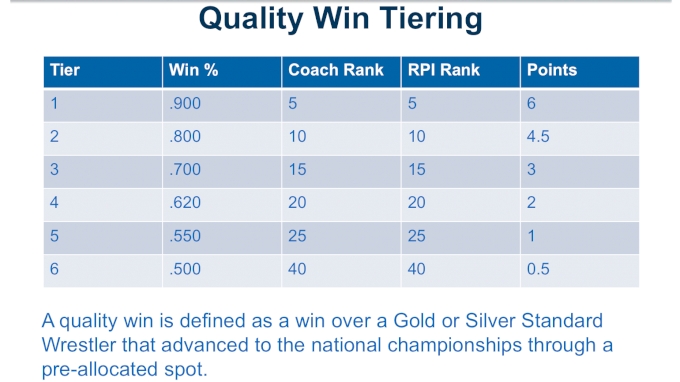How Does The NCAA Seeding Process Work?
How Does The NCAA Seeding Process Work?
A brief explanation of how the NCAA determines the seeds for the national tournament.

While it would have been cool to give the people NCAA championship seed projections prior to the release of the brackets Wednesday, there are just too many unknowns. So instead, we're going to explain how next week's NCAA tournament in Cleveland is seeded.
Here are the initial criteria you need to know, and then we will explain how they are applied:
- Head-to-head competition — 25 percent
- Quality wins — 20 percent
- Coaches Ranking — 15 percent
- Results against common opponents — 10 percent
- RPI — 10 percent
- Qualifying event placement — 10 percent
- Win % — 10 percent
Now, what does all that mean? It means there are seven categories used to weigh all 33 qualifiers against each other. Essentially, these numbers are run head-to-head against the entirety of the field 32 times over, which means that every qualifier is assigned a rank within the seeding matrix.
Let's use last year's #1 and #2 seeds at 125 as an approximate example.
Thomas Gilman | Joey Dance | |
12.5 | Head-to-Head | 12.5 |
20 | Quality Wins | 0 |
15 | Coaches Ranking | 0 |
5 | Common Opponents | 5 |
10 | RPI | 0 |
5 | Conference Placement | 5 |
10 | Win Percentage | 0 |
77.5 | Total | 22.5 |
By the seeding formula, Gilman clearly has a better resume. They tie for points, as they did not meet head-to-head. Both won all of their matches against common opponents and both took first in their conference. This exercise is then repeated over and over until each wrestler in the field has a "record" against the other 32 wrestlers. So, if Gilman was superior to everyone else in the 125lb bracket, he would have gotten 32 points. If Dance's only "loss" was to Gilman, he'd be given 31 points.
So this sets a baseline for the seeding committee but is not always final. According to Stanford head coach Jason Borrelli in his interview on FRL 18, a wrestler can only be argued up or down if he is within three points of the other wrestler. This allows some level of subjectivity and might catch things the formula could miss.
As a hypothetical, this could come into play at 157 this year for Michigan's Alec Pantaleo and Ohio State's Micah Jordan. Let's say Jordan has 29 points and Pantaleo has 28 points after they run the matrix. Someone on the committee could make the argument that there is no way Pantaleo should be below Jordan since the UM senior beat the OSU redshirt junior three separate times.
But of course, not everything is so black and white — there are shades of gray. A quality win is defined here as:
A win over any wrestler in the field. Throughout at-large consideration, that will include wins over AQ wrestlers. During seeding, that will include all 33 wrestlers at each weight class.


What you see above is a rather confusing explanation that quality wins are given tiers. In the first picture, it says Tier 1 wins are worth six points. But on the following page in image two, wrestler B has three Tier 1 wins but fewer than 18 points. The other important thing to remember is that quality wins only count one time. This means Myles Martin has three wins over Dom Abounader, but he only gets "credit" for one. So who really knows how quality wins work.
Just know that for someone like, say, Austin DeSanto, his win over Stevan Micic is more valuable than his win over Dennis Gustafson. This also seems to imply that the 20 points for the matrix are not all or nothing.
The other questions about the matrix are about RPI and win percentage. RPI stands for Ratings Percentage Index and is used in just about every collegiate sport to help determine the field for its respective national championships. According to page 13 here, "RPI is defined as Win %*, opponents’ Win %*, opponents’ opponents’ Win % (17-match minimum)." That same page defines win percentage, "as Division I wins divided by total Division I matches contested."
The 2018 NCAA brackets are being released Wednesday at 5 PM Central time. Along with that, we'll get the final RPI and coaches ranking for the year. So if you want to complain about seeds or argue them publicly with other people, remember to arm yourself with knowledge!